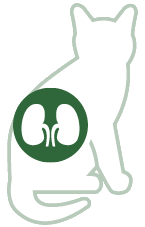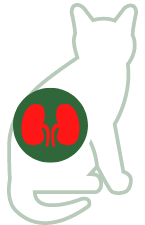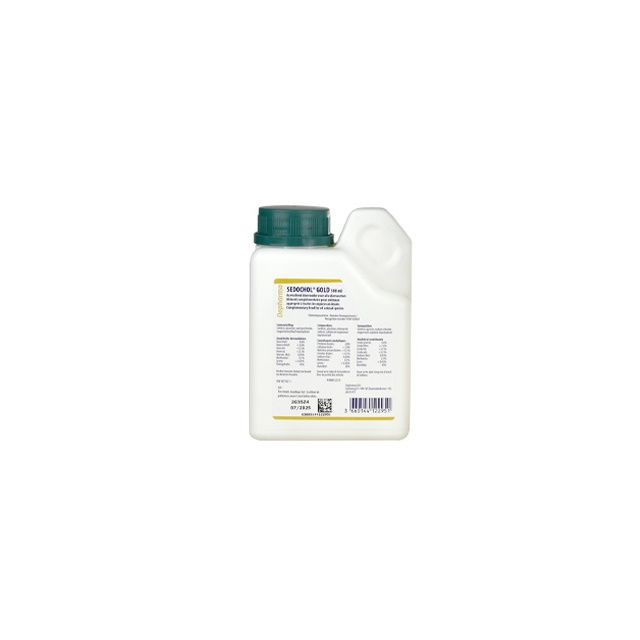Kidneys, bladder and urinary tract of the cat
Bladder problems are among the most common reasons for a visit to the vet. Urinating outside the litter box is a frequent sign of a bladder infection in cats. Besides being unpleasant for your cat, bladder problems are also annoying for you! More than a third of cats older than fifteen years develop chronic kidney disease. This is reason enough to do everything possible to support the urinary tract of your beloved pet. Pharmacy4pets is happy to help keep your cat's kidneys and bladder in the best possible condition.
The Urinary Tract of the Cat
Under the term 'urinary tract', the two kidneys are included, which via the ureters lead to the bladder, where the urine is collected to be expelled through the urethra from the external genital opening.
The Kidneys
The kidneys are bean-shaped structures located high against the back of your cat, about at the last ribs. The kidneys are among the most important organs of the body. They are crucial for maintaining a good fluid balance and filtering the blood. This is done in countless small 'filter factories' (called nephrons). All the blood is pumped through the nephrons, where useful particles (such as certain salts and proteins) are reabsorbed and toxins and waste products are expelled from the body. The kidneys produce urine. A cat weighing 4.5 kg produces about 28 ml of urine daily.
The Bladder of the Cat
The bladder stores urine until the cat needs to urinate. The sphincter ensures that the bladder remains closed until then. Since cats are originally desert animals, they can concentrate their urine very strongly. This can sometimes lead to problems because certain salts are less soluble in highly concentrated urine, leading to the formation of bladder grit. Compare a spoonful of sugar in a very small amount of water or in a full glass. The inside of the bladder is lined with a mucous membrane layer with glycosaminoglycans.
Kidney Diseases
More than 30% of cats over the age of 15 develop chronic kidney disease. In this condition, the kidneys shrivel and the nephrons are destroyed, causing the kidney to no longer concentrate the urine and lose its filtering function. As a result, the cat loses many useful nutrients such as proteins and certain salts (for example, potassium). Unfortunately, chronic kidney disease is incurable. However, timely support with diet food (the main pillar in the management of chronic kidney disease!), supplements like Ipakitine or Pronefra and sometimes medication can often allow cats to lead a happy life for a considerable time.
Kidney disease can also occur very acutely. This is often caused by (an overdose of) certain medications and toxins. Lilies are notorious among cats. Acute kidney disease can sometimes be cured by intensive treatment with fluid infusions. A kidney pelvis infection is a bacterial inflammation of the inner part of the kidney, the kidney pelvis. A kidney pelvis infection often arises from a neglected bacterial bladder infection. In rare cases, kidney or ureter stones may occur.
An infection of the kidney pelvis, the inner part of the kidney, often arises from a neglected bacterial bladder infection. In rare cases, kidney or ureter stones may occur.
Symptoms of Kidney Problems
Since often a large part of kidney function is already lost by the time the disease is discovered, it is very important to be alert to the symptoms of kidney problems in cats:
- Weight loss.
- Drinking and urinating a lot or not producing urine at all (the latter is an emergency!).
- Larger than normal urine output (the litter box gets dirty faster and you see larger clumps of wet cat litter).
- Poor appetite.
- Vomiting.
- Being generally sick or weak.
- Producing more saliva or smacking (due to nausea or ulcers in the mouth).
- With low potassium levels: holding the head and neck down.
- With a kidney pelvis infection: going to the litter box more often, urinating outside the litter box, blood or pus in the urine, foul-smelling urine, difficulty urinating.
Bladder Problems in Cats
Bladder problems can be very frustrating. They can recur regularly and because a major symptom in many cats is not using the litter box, but urinating on the bed or couch, it also has a significant impact on you as the owner.
There are various causes for cat bladder infection, but the most common is ‘feline idiopathic cystitis’ (FIC). This is a complex medical term for a bladder infection in cats whose exact cause is not precisely known. What we do know is that often multiple factors play a role: diet, obesity, inactivity, drinking too little, holding urine for too long, stress, and dissatisfaction with the litter box. Furthermore, bladder grit and bladder stones also occur regularly.
Note: Male cats have a very narrow urethra that can easily become blocked by, for example, blood, inflammatory cells, and crystals (bladder grit). Besides being very painful, a blocked urethra is also life-threatening: your cat cannot eliminate toxins. If you are unsure whether your male cat is actually urinating when he goes to the litter box, or if you see no urine or only a few drops, call the vet immediately, even in the evening or on the weekend!
If your cat has urinary problems, your veterinarian will want to conduct a urine analysis. You can collect urine at home for this purpose. With special cat litter pellets that do not absorb moisture, this is a breeze! If your cat does not have real urinary complaints, but you are unsure whether you have seen blood in your cat's urine, you can also test the urine yourself with a home urine test. However, this does not replace an examination by your veterinarian: they will also want to determine the concentration of the urine and check for the presence of inflammatory cells, bladder grit, blood, and bacteria under the microscope.
Symptoms of Bladder and Urinary Problems
When your cat suffers from bladder and urinary problems, these are often recognizable by the following symptoms:
- Frequent visits to the litter box / wanting to go outside.
- Incontinence.
- Painful expressions while urinating (growling, hissing).
- Doing many small pees.
- Licking the genital area.
- Blood in the urine.
- Drinking a lot and urinating a lot.
- General illness.
- Inability to urinate (Note: this is an emergency!).
Treatment of Urinary Problems
Because there are many different possible causes of your cat's bladder problems, there are also many different treatments. It is extremely important, especially with recurring bladder infections, to have a correct diagnosis made by your veterinarian. Examples of treatments for bladder problems in cats include:
- Painkillers and anti-inflammatories.
- Dietary food that reduces the chance of bladder grit formation.*
- Supplements that affect the acidity of the urine, such as Vetoquinol Care Bladder Grit Gel.*
- Supplements such as the Feluro suspension that influence the glycosaminoglycans in the bladder wall.
- Calming products such as Zylkene or Feliway.
- Encouraging more drinking with a drinking fountain.
- Modifications to the litter box.
- Behavioral therapy.
- Weight loss and more exercise.
- Surgery.
* Incorrect use of, for example, food or supplements can have adverse effects! Certain types of bladder grit develop more easily in alkaline urine, others in acidic urine. Arbitrarily acidifying the urine can therefore exacerbate the problem. Always consult with your veterinarian before changing your cat's diet or starting certain supplements.
If you suspect that your cat has kidney or bladder problems, a proper diagnosis by the veterinarian is essential. Pharmacy4pets has a wide range of supportive products for the urinary tract. If you have any questions about our products or about urinary tract problems in your cat, please contact us.




